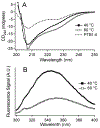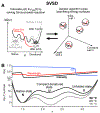A natural missing link between activated and downhill protein folding scenarios
- PMID: 20336253
- PMCID: PMC7382783
- DOI: 10.1039/b925033f
A natural missing link between activated and downhill protein folding scenarios
Abstract
We propose protein PTB1 : 4W as a good candidate for engineering into a downhill folder. PTB1 : 4W has a probe-dependent thermal unfolding curve and sub-millisecond T-jump relaxation kinetics on more than one time scale. Its refolding rate in denaturant is a non-linear function of denaturant concentration (curved chevron plot). Yet at high denaturant concentration its unfolding is probe-independent, and the folding kinetics can be fitted to a single exponential decay. The domain appears to fold via a mechanism between downhill folding and activated folding over several small barriers, and when denaturant is added, one of these barriers greatly increases and simplifies the observed folding to apparent two-state kinetics. We predict the simplest free energy function consistent with the thermal denaturation and kinetics experiments by using the singular value Smoluchowski dynamics (SVSD) model. PTB1 : 4W is a natural 'missing link' between downhill and activated folding. We suggest mutations that could move the protein into the downhill folding limit.
Figures








Similar articles
-
Thermodynamics of downhill folding: multi-probe analysis of PDD, a protein that folds over a marginal free energy barrier.J Phys Chem B. 2014 Jul 31;118(30):8982-94. doi: 10.1021/jp504261g. Epub 2014 Jul 21. J Phys Chem B. 2014. PMID: 24988372
-
Slow proton transfer coupled to unfolding explains the puzzling results of single-molecule experiments on BBL, a paradigmatic downhill folding protein.PLoS One. 2013 Oct 28;8(10):e78044. doi: 10.1371/journal.pone.0078044. eCollection 2013. PLoS One. 2013. PMID: 24205082 Free PMC article.
-
Exploring one-state downhill protein folding in single molecules.Proc Natl Acad Sci U S A. 2012 Jan 3;109(1):179-84. doi: 10.1073/pnas.1111164109. Epub 2011 Dec 19. Proc Natl Acad Sci U S A. 2012. PMID: 22184219 Free PMC article.
-
Protein folding in the landscape perspective: chevron plots and non-Arrhenius kinetics.Proteins. 1998 Jan;30(1):2-33. doi: 10.1002/(sici)1097-0134(19980101)30:1<2::aid-prot2>3.0.co;2-r. Proteins. 1998. PMID: 9443337 Review.
-
Limited cooperativity in protein folding.Curr Opin Struct Biol. 2016 Feb;36:58-66. doi: 10.1016/j.sbi.2015.12.001. Epub 2016 Feb 2. Curr Opin Struct Biol. 2016. PMID: 26845039 Review.
Cited by
-
Parallel folding pathways of Fip35 WW domain explained by infrared spectra and their computer simulation.FEBS Lett. 2017 Oct;591(20):3265-3275. doi: 10.1002/1873-3468.12836. Epub 2017 Sep 21. FEBS Lett. 2017. PMID: 28881468 Free PMC article.
-
The role of high-dimensional diffusive search, stabilization, and frustration in protein folding.Biophys J. 2014 Apr 15;106(8):1729-40. doi: 10.1016/j.bpj.2014.01.051. Biophys J. 2014. PMID: 24739172 Free PMC article.
-
Nonadditivity in conformational entropy upon molecular rigidification reveals a universal mechanism affecting folding cooperativity.Biophys J. 2011 Feb 16;100(4):1129-38. doi: 10.1016/j.bpj.2011.01.027. Biophys J. 2011. PMID: 21320459 Free PMC article.
References
-
- Kubelka J; Hofrichter J; Eaton WA. Curr. Opinion. Struct. Bio, 2004, 14, 76–88. - PubMed
-
- Gruebele M. Comptes Rendus Biol, 2005, 328, 701–712. - PubMed
-
- Munoz V. Ann. Rev. Biophys. Biomol. Struct, 2007, 36, 395–412. - PubMed
-
- Zhang J; Li WF; Wang J; Qin M; Wang W. Proteins-Struct. Funct. Bioinformatics, 2008, 72, 1038–1047. - PubMed
Publication types
MeSH terms
Substances
Grants and funding
LinkOut - more resources
Full Text Sources

